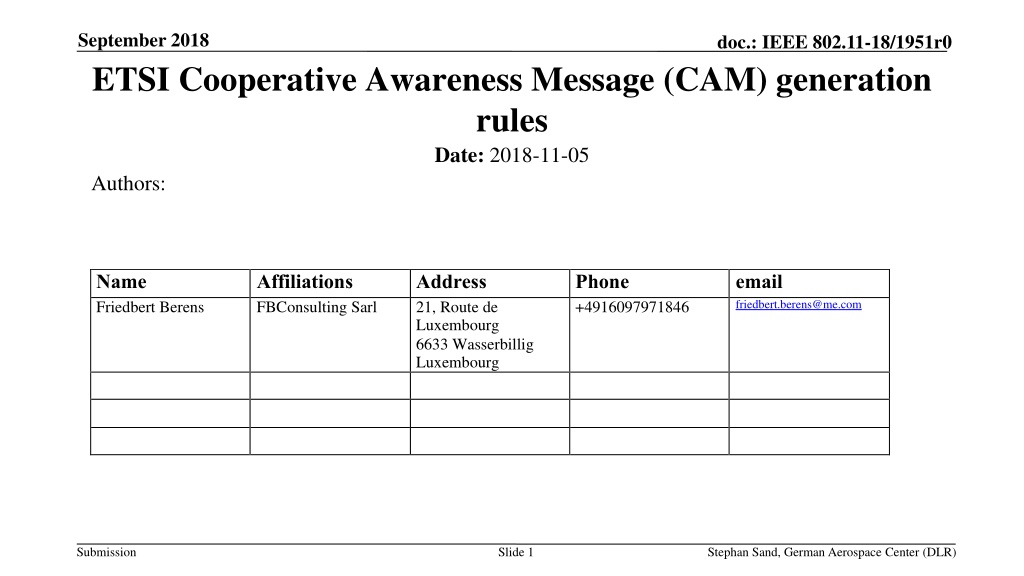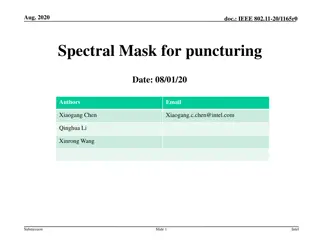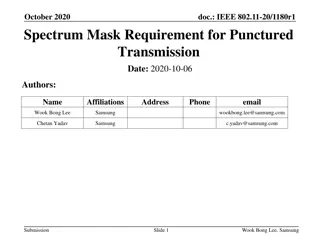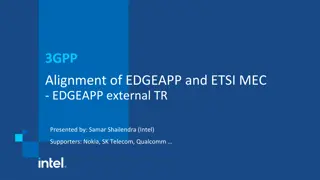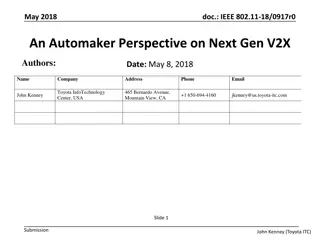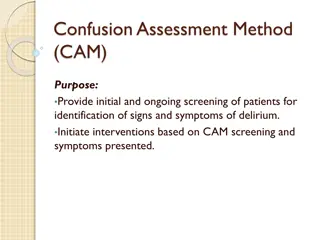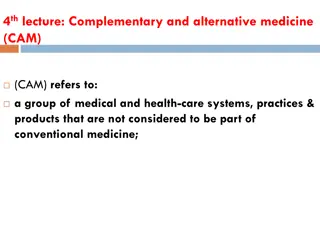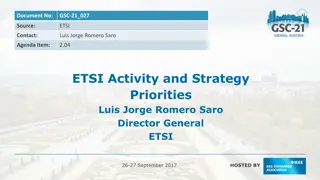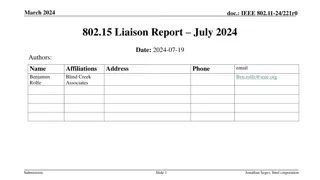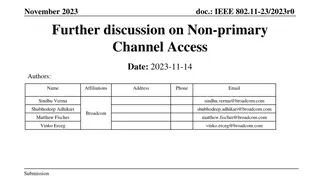IEEE 802.11-18/1951r0 ETSI CAM Generation Rules
ETSI EN 302.637.2 defines the structure and generation rules of Cooperative Awareness Messages (CAMs) for Intelligent Transportation Systems (ITS). CAMs are essential for a variety of ITS use cases and must be backward compatible in NGV systems. The CAM messages are non-deterministic in time and size, varying based on speed, heading, and acceleration. This document highlights the basic generation rules, CAM structure, inter-CAM spacing, and variable CAM message sizes for different scenarios.
Download Presentation

Please find below an Image/Link to download the presentation.
The content on the website is provided AS IS for your information and personal use only. It may not be sold, licensed, or shared on other websites without obtaining consent from the author.If you encounter any issues during the download, it is possible that the publisher has removed the file from their server.
You are allowed to download the files provided on this website for personal or commercial use, subject to the condition that they are used lawfully. All files are the property of their respective owners.
The content on the website is provided AS IS for your information and personal use only. It may not be sold, licensed, or shared on other websites without obtaining consent from the author.
E N D
Presentation Transcript
September 2018 doc.: IEEE 802.11-18/1951r0 ETSI Cooperative Awareness Message (CAM) generation rules Date: 2018-11-05 Authors: Name Friedbert Berens Affiliations FBConsulting Sarl Address 21, Route de Luxembourg 6633 Wasserbillig Luxembourg Phone +4916097971846 email friedbert.berens@me.com Submission Slide 1 Stephan Sand, German Aerospace Center (DLR)
September 2018 doc.: IEEE 802.11-18/1951r0 Abstract ETSI EN 302 637 2 defines the structure and generation rules of CAMs: Cooperative Awareness Message (CAM) Core message for a broad range of ITS use cases for day one and day two applications Will have to be support in a fully backward compatible way in all new versions of a NGV system CAM messages are non-deterministic in time and size Period varies from 1Hz to 10Hz depending on the generation rules based on speed, heading and acceleration Size varies from around 200 bytes to up to more than 700 Bytes depending on the environment and security content Submission Slide 2 Friedbert Berens, FBConsulting Sarl
September 2018 doc.: IEEE 802.11-18/1951r0 CAM structure Submission Slide 3 Friedbert Berens, FBConsulting Sarl
September 2018 doc.: IEEE 802.11-18/1951r0 Basic generation rules Speed: A change in position by more than 4m Heading: a change of direction of equal or more than +/- 4 Change of speed: A change of speed equal to or larger than 0,5m/sec Extrem values: Minimum rate is 1Hz, Maximum rate is 10Hz Submission Slide 4 Friedbert Berens, FBConsulting Sarl
September 2018 doc.: IEEE 802.11-18/1951r0 Inter-CAM spacing in seconds, Sub Urban scenario Max speed: 60km/h Sub-Urban/Industrial area Main factor: Acceleration Steering Inter-CAM spacing in seconds CAM number Submission Slide 5 Friedbert Berens, FBConsulting Sarl
September 2018 doc.: IEEE 802.11-18/1951r0 Variable CAM message size, highway scenario CAM size in byte over transmission number, highway scenario Max speed: 130km/h Rural highway 700 600 500 CAM size in bytes 400 300 200 100 0 1 2 3 4 5 6 7 8 9 10 11 12 13 14 15 number of transmission 16 17 18 19 20 21 22 23 24 25 26 27 28 29 30 31 32 33 34 Submission Slide 6 Friedbert Berens, FBConsulting Sarl
September 2018 doc.: IEEE 802.11-18/1951r0 Conclusion CAM generation based on ETSI EN 302 637 2 is a highly dynamic and non-deterministic process The dynamic generation rule guarantees an efficient resource usage since only actually required information are send out (spectrum efficiency) CAM instantaneous rate can vary from 1Hz to 10Hz from one generated CAM to the next one CAM size is depending on the actual content an can vary from around 200 Bytes to more than 700Bytes In the future smaller (pedestrian) and larger CAM sizes are possible Submission Slide 7 Friedbert Berens, FBConsulting Sarl
